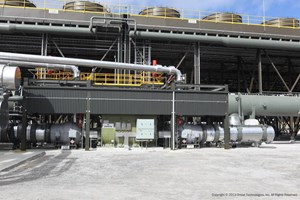It’s been a long time coming, but with financing secured, construction will finally begin on the world’s largest geothermal power plant – the Sarulla Geothermal Power Project in Indonesia.
In the works since 1990, the $1.2 billion, 330 megawatt (MW) project is about to break ground, with the first phase online in 2016 and the entire project by 2018. It’s been delayed by many factors, such as the 1990s Asian financial crisis, complex regulations and difficulty in finding financing for geothermal – which is still expensive to develop.
Although Indonesia is geothermal-rich, with about 40% of the world’s reserves, it currently taps into only 4-5% of that even with a geothermal tariff. At 227 MW, Wayang Windu Geothermal Power Station in West Java
is the largest project to date.
One constraint has been an Indonesian law that lumps geothermal energy extraction in the same category as strip mining. Parliament finally passed legislation last year that corrects that.
Eight mostly Asian and Australian banks are financing the project, which is owned by a consortium of several Asian power providers. The model is being called a breakthrough for accelerating geothermal development in Indonesia. Ormat, the world’s leading geothermal developer, designed the plant using its efficient technology and also has an equity stake.

Indonesia’s goal is for geothermal to provide 12% of its energy by 2025, but the slow pace of development likely makes this target unrealistic. Electricity demand is rising 7% a year and blackouts have become common.
US National Geothermal Database
Right now, the US leads the world on geothermal energy
production, but development is also slow here. The sector lags other renewables with only about 5% growth a year and 3.4 gigawatts installed, mostly in California and Nevada.
To accelerate development, the Department of Energy (DOE)launched the National Geothermal Database this spring. The goal is to facilitate R&D that can better pinpoint geothermal reserves and drive down the cost of exploration.
"This innovative online tool will allow academia and industry to access quantifiable, technical data in digital format, breaking down one of the geothermal energy industry’s greatest barriers to development and deployment of this promising clean energy source," says DOE.
The open source platform encompasses thousands of databases, geologic maps, and reports, drawing from millions of previously unavailable digitized records that can aid discovery of geologic features, faults, seismicity, heat flow, geochemistry, drilling, and temperatures at various depths and in specific geographic areas. The industry is already making use of the tool to simulate geological features and locate and monitor geothermal reservoirs beneath the Earth’s surface.
DOE also announced $18 million in research grants for 32 projects that will advance geothermal development: advancing subsurface analysis and engineering techniques for enhanced geothermal (EGS); Play Fairway Analysis – a mapping approach that reveals geothermal resources; combining geothermal and mineral extraction such as rare earths and lithium. Together, these projects will lower the cost and risk of geothermal development.
Universities Go Geothermal
in related news, three US universities have made major commitments to run on geothermal energy.
Indiana’s Ball State University announced it would switch from coal to geothermal a couple of years ago and now Missouri University’s Science and Technology campus is following suit. It shut down a World War II-era coal plant and will run on geothermal starting this fall. Four geothermal plants will heat and cool 17 buildings on campus providing half the energy and eliminating $34 million needed to upgrade the old coal plant. A university-issued bond financed the project, which will be repaid ot of the $1 million a year in energy savings.
Oregon Institute of Technology runs on 100% renewable energy by combining solar and geothermal
Their Klamath Falls campus is currently the only university in the world that is completely heated by geothermal water, and it has the first university-based geothermal combined heat and power plant in the world.
Geothermal will also be the sole power source for California’s Sonoma Clean Power, a new municipal utility.
Read our article, Geothermal Still the Underdog of Renewables, But Prospects Are Brighter.
National Geothermal Database is here:

